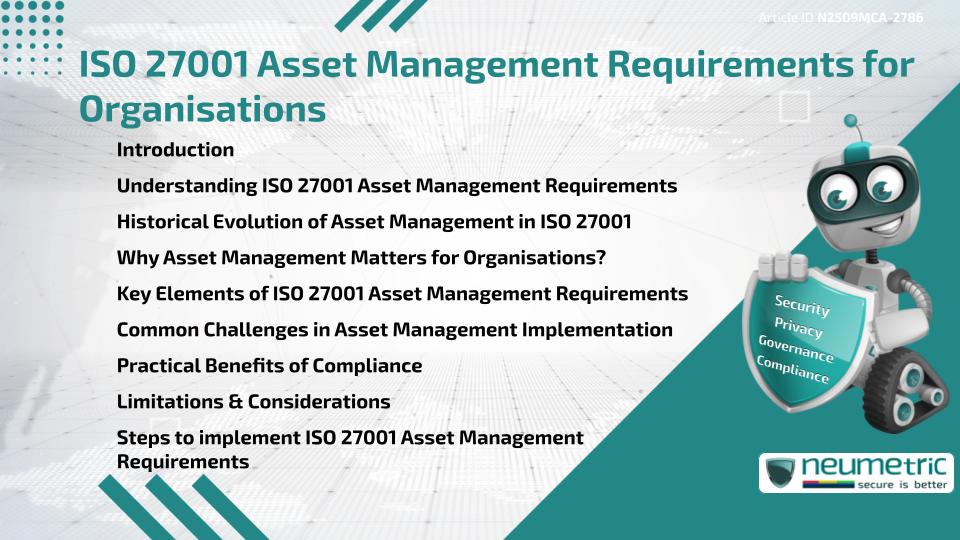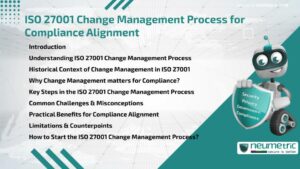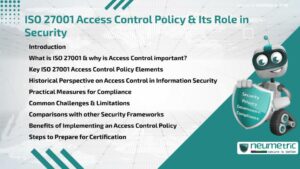Table of Contents
ToggleIntroduction
The ISO 27001 asset management requirements provide a structured Framework for identifying, classifying & safeguarding information assets. For organisations, meeting these requirements is critical to reduce Risks, ensure compliance & build Stakeholder trust. Asset management within ISO 27001 ensures that every piece of information, whether digital, physical or intellectual, is properly managed throughout its lifecycle. This article explores the evolution, importance, key elements, challenges & benefits of adopting the ISO 27001 asset management requirements.
Understanding ISO 27001 Asset Management Requirements
At its core, ISO 27001 emphasizes an Information Security Management System [ISMS] that protects organisational assets. The asset management requirements within the Standard ensure that organisations maintain an accurate inventory, assign ownership & apply controls to safeguard information. Assets can include hardware, software, databases, documents & even knowledge. The ISO 27001 asset management requirements help organisations establish accountability & reduce Risks related to misuse, loss or breaches.
Historical Evolution of Asset Management in ISO 27001
Asset management practices within ISO standards date back to the early British Standard BS 7799. Over time, as technology advanced & data became a core business driver, ISO 27001 incorporated specific clauses addressing asset identification & control. These requirements reflect decades of learning about how mismanaged assets contribute to Vulnerabilities. The emphasis on lifecycle management highlights a recognition that assets evolve, require updates & must be securely disposed of when no longer needed.
Why Asset Management Matters for Organisations?
Organisations rely on information assets for decision-making, Customer engagement & operations. Poorly managed assets can result in data leaks, inefficiencies or compliance failures. The ISO 27001 asset management requirements ensure that leaders understand what assets exist, who owns them & how they are protected. By implementing effective asset management, organisations can:
- Strengthen accountability
- Reduce operational Risks
- Meet regulatory obligations
- Gain trust from clients & Stakeholders Asset management serves as the backbone of any effective Information Security program.
Key Elements of ISO 27001 Asset Management Requirements
The Standard outlines several important elements:
- Asset inventory: Creating & maintaining an up-to-date list of all information assets.
- Ownership assignment: Clearly defining responsibility for each asset.
- Classification: Categorizing assets based on sensitivity & importance.
- Handling procedures: Establishing rules for using, sharing, storing & disposing of assets.
- Lifecycle management: Ensuring assets are tracked from creation to disposal. These elements ensure consistency, accountability & protection across the organisation.
Common Challenges in Asset Management Implementation
While the benefits are clear, implementing the ISO 27001 asset management requirements can be challenging. Organisations often struggle with:
- Maintaining accurate & current asset inventories.
- Assigning clear ownership in complex structures.
- Ensuring staff awareness & compliance with procedures.
- Managing diverse asset types across multiple systems. Overcoming these hurdles requires leadership commitment, training & the integration of supporting tools.
Practical Benefits of Compliance
Complying with ISO 27001 asset management requirements provides numerous advantages:
- Improved visibility & control over assets.
- Reduced Risks of breaches & data loss.
- Streamlined compliance with other regulations.
- Enhanced organisational efficiency.
- Stronger trust from clients, partners & regulators. These benefits directly contribute to long-term resilience & competitive advantage.
Limitations & Considerations
While ISO 27001 sets a strong Framework, it is not a guarantee of absolute security. Organisations may face challenges in scaling asset management requirements to large or dynamic environments. Additionally, implementing controls requires resources & consistent oversight. The Standard should be viewed as a guide for Best Practices rather than a complete solution.
Steps to implement ISO 27001 Asset Management Requirements
Organisations can take the following steps:
- Conduct a baseline asset inventory.
- Assign clear ownership & responsibilities.
- Develop classification & handling procedures.
- Train staff on responsibilities & security awareness.
- Review & update the asset register regularly.
- Perform audits to ensure compliance & improvement. By following these steps, organisations can embed asset management practices into daily operations.
Takeaways
- The ISO 27001 asset management requirements provide a structured approach to managing assets.
- Asset management reduces Risks & strengthens accountability.
- Benefits include improved efficiency, compliance & trust.
- Implementation challenges exist but can be overcome with leadership support.
- Regular reviews & staff training are essential for long-term success.
FAQ
What are ISO 27001 asset management requirements?
They are guidelines within ISO 27001 that require organisations to identify, classify, assign ownership & manage information assets.
Why are ISO 27001 asset management requirements important?
They help reduce Risks, ensure compliance & maintain trust by protecting critical organisational assets.
What types of assets are covered under ISO 27001 asset management requirements?
Assets include hardware, software, documents, databases & Intellectual Property.
How do organisations implement ISO 27001 asset management requirements?
By conducting inventories, assigning ownership, classifying assets & applying handling procedures throughout the asset lifecycle.
Do ISO 27001 asset management requirements guarantee security?
No, they reduce Risks significantly but do not eliminate all Threats.
Can Small Businesses meet ISO 27001 asset management requirements?
Yes, requirements can be scaled to match the size & complexity of the organisation.
What happens if asset management requirements are not followed?
Failure can result in data loss, compliance issues, reputational damage & operational disruptions.
Need help for Security, Privacy, Governance & VAPT?
Neumetric provides organisations the necessary help to achieve their Cybersecurity, Compliance, Governance, Privacy, Certifications & Pentesting needs.
Organisations & Businesses, specifically those which provide SaaS & AI Solutions in the Fintech, BFSI & other regulated sectors, usually need a Cybersecurity Partner for meeting & maintaining the ongoing Security & Privacy needs & requirements of their Enterprise Clients & Privacy conscious Customers.
SOC 2, ISO 27001, ISO 42001, NIST, HIPAA, HECVAT, EU GDPR are some of the Frameworks that are served by Fusion – a SaaS, multimodular, multitenant, centralised, automated, Cybersecurity & Compliance Management system.
Neumetric also provides Expert Services for technical security which covers VAPT for Web Applications, APIs, iOS & Android Mobile Apps, Security Testing for AWS & other Cloud Environments & Cloud Infrastructure & other similar scopes.
Reach out to us by Email or filling out the Contact Form…





